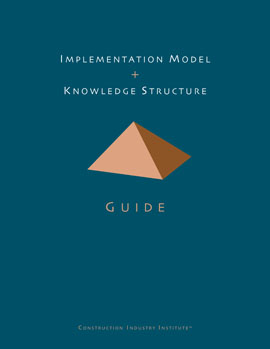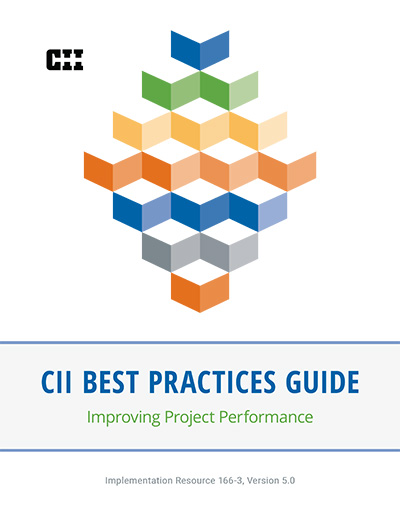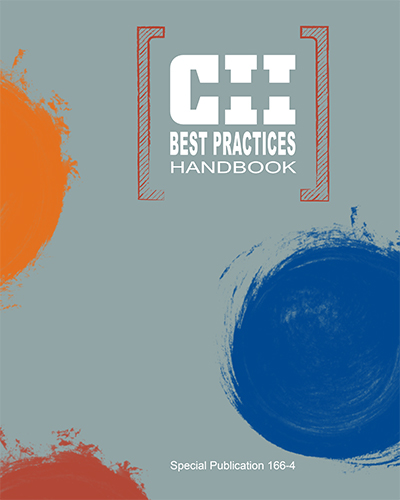
Implementation Model + Knowledge Structure Guide
Since its initiation in 1983, CII has performed valuable research and produced many project management processes and tools that have great potential to improve the construction industry. However, implementation of CII products has still been somewhat disappointing. In order to facilitate effective implementation of CII products, the CII Implementation Strategy Committee (ISC) was formed in 1995 and has focused its efforts to increase the level of implementation of best practices within CII member companies.
In order to help member companies implement CII products effectively, the CII ISC has developed the CII Implementation Model which summarizes the needed steps to effective implementation of best practices. It also sponsored the CII Knowledge Team that recently developed the CII Knowledge Structure, logically organizing all CII products and research findings. This document will summarize each of these efforts and provide guidance to organizations wishing to implement CII products.
The CII Implementation Model contains a foundation and nine building blocks to help develop an organization’s implementation effort. The foundation and building blocks are discussed,including key issues that need to be pursued by organizations wishing to improve implementation of CII products.
One of the biggest complaints concerning implementation of CII products has been the sheer volume of reports and tools and the difficulty with finding the “right practice” to implement. A logical structure was developed in order to organize CII’s efforts since 1983 and facilitate identification of best practices. This development, called the CII Knowledge Structure, including CII Best Practices and definitions of terms related to the Knowledge Structure, is explained in this document. The CII Knowledge Structure consists of 13 Knowledge Areas that are broken into 47 Focus Areas, which are further divided into 11 Best Practices, 12 Proposed Best Practices, and 24 Information Areas. Each Focus Area is supported by various CII products such as tools, products, and/or references. The Knowledge Structure gives an organization a key mechanism for supporting its implementation efforts.
The CII Knowledge Structure is the overall body of CII knowledge arranged in topological form. It provides an easy mechanism for finding and using CII products. (IR166-2, p. 9)
The CII Knowledge Structure is broken into 13 Knowledge Areas. A Knowledge Area is defined as logical grouping of CII topical areas and reflects project phases or specific topics, project management techniques or issues. The 13 CII Knowledge Areas are:
- Front End Planning
- Design
- Procurement
- Construction
- Startup and Operation
- People
- Organization
- Project Processes
- Project Controls
- Contracts
- Safety, Health, and Environment
- Information/Technology Systems
- Globalization Issues
Each Knowledge Area is subdivided into Focus Areas that include Best Practices, Proposed Best Practices – Pending Validation, and/or Information.
A CII Best Practice is defined as a process or method that, when executed effectively, leads to enhanced project performance. (IR166-2, p. 14)
CII Best Practices identified by this research include:
- Pre-Project Planning
- Alignment
- Constructability
- Design Effectiveness
- Materials Management
- Team Building
- Partnering
- Quality Management
- Change Management
- Disputes Resolution
- Zero Accidents Techniques
Three recommendations to improve your implementation efforts. (IR166-2, p. 17)
- Use the CII Implementation Model as a basis to develop an implementation program within your organization.
- Use the CII Knowledge Structure to identify Best Practices to adapt within your company.
- Implement CII Best Practices within your organization.
This publication has been archived, but is available for download for informational purposes only. Note: its updates to the Implementation Model and Implementation Thermometer are now included in IR166-3. Provides an understanding of the CII Implementation Model and CII Knowledge Structure (circa 2000).



